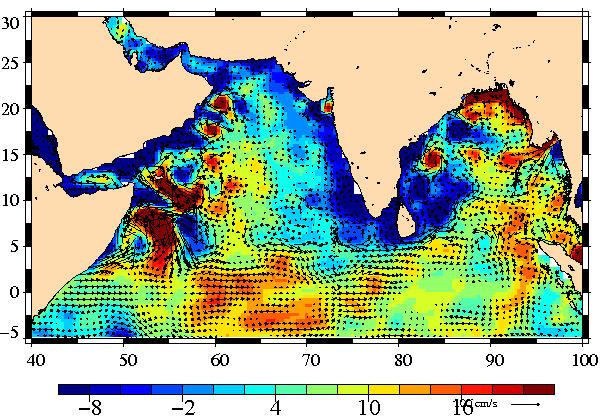Monsoon
Monsoon is one of the major climatic features on Earth, vital for people living under its influences. Studying its cycle and predicting its shifts is of enormous benefit because of their dramatic environmental and societal impacts when floods and droughts occur. Altimetry data able us to study oceanic currents and their variations. By using them in coupled ocean-atmosphere forecasting models, they could help estimate the next monsoon.
Monsoon involves both ocean and atmophere, with a seasonal shift where the winds completely reverse their direction. Thus we may speak of summer and winter monsoon. The major monsoon systems of the world consist of the West African and Asia monsoons. The Indian Summer monsoon (June-September) is wet whereas the Indian Winter monsoon (November- February) is dry. In the Summer, the land warms more than the ocean. This heated air over the land rises. While it rises vertically, it cools. To replace it, humid air from the ocean moves in. As the humid air warms over the land, it too rises and the water condenses into rain. In Winter, the reverse occurs.
Asian Summer monsoon knows interannual variations for a variety of reasons (Eurasian snow cover, winds circulation, ENSO, IOD, ...). It's widely known that one of the strongest influences on the Asian Monsoon is the ENSO oscillation. During La Niña years, the western Pacific Ocean is warmer (it's current situation on July 2010 - see all maps here). The Indian Ocean Dipole (IOD) also plays an important role as a modulator of the Summer Monsoon rainfall : rainfall remains above normal during a positive IOD. A three-way link between ENSO, the Indian Summer Monsoon Rainfall and the Indian Ocean Dipole can be established but it is complex.
Maps of Sea Level Anomalies (in cm) and geostrophic currents (in cm/s) on 2012/08/03 over the Indian Ocean (merged NRT Duacs data). An animation between 2012/05/01 and 2012/08/03 can be downloaded here (format .avi, 1.5 MB). Crédits Cnes/CLS.
- News, 2010-08-11 High floods in India and Pakistan
- Earth Observatory website (2010/08/12): Unusually Intense Monsoon Rains
- Izumo T. et al. (2010): Influence of the state of the Indian Ocean Dipole on the following year's El Niño. Nature Geoscience 3, 168 - 172. doi :10.1038/ngeo760.
- (2001), Impact of the Indian Ocean dipole on the relationship between the Indian monsoon rainfall and ENSO, Geophys. Res. Lett., 28(23), 4499–4502, doi:10.1029/2001GL013294.





